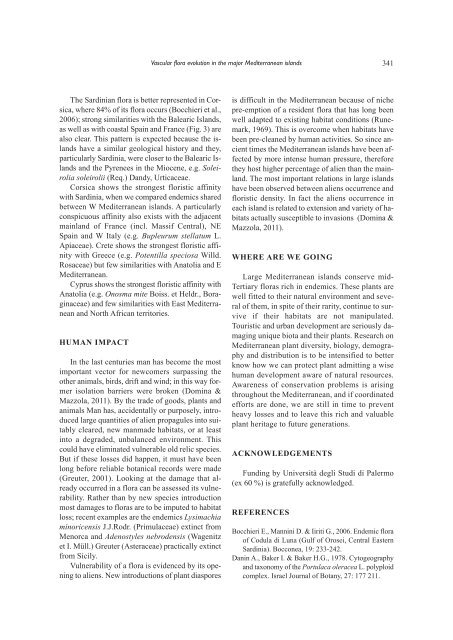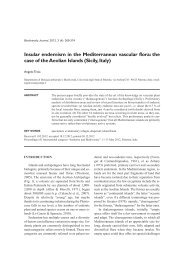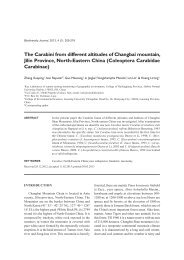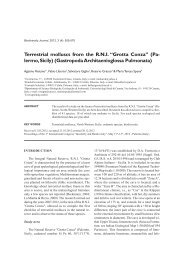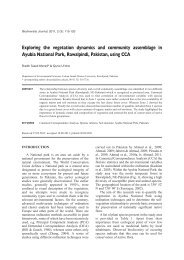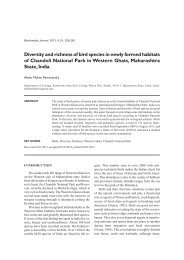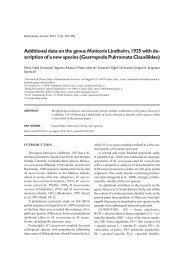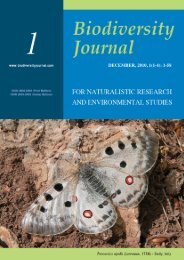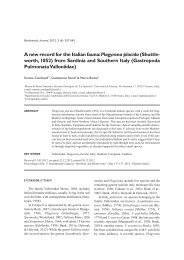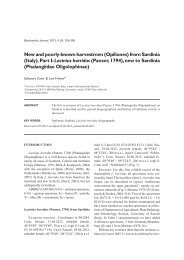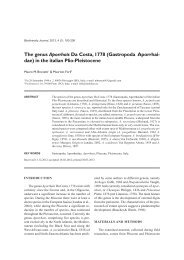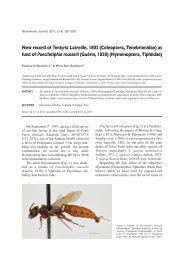Vascular flora evolution in the major Mediterranean islands
Vascular flora evolution in the major Mediterranean islands
Vascular flora evolution in the major Mediterranean islands
You also want an ePaper? Increase the reach of your titles
YUMPU automatically turns print PDFs into web optimized ePapers that Google loves.
<strong>Vascular</strong> <strong>flora</strong> <strong>evolution</strong> <strong>in</strong> <strong>the</strong> <strong>major</strong> <strong>Mediterranean</strong> <strong>islands</strong>341The Sard<strong>in</strong>ian <strong>flora</strong> is better represented <strong>in</strong> Corsica,where 84% of its <strong>flora</strong> occurs (Bocchieri et al.,2006); strong similarities with <strong>the</strong> Balearic Islands,as well as with coastal Spa<strong>in</strong> and France (Fig. 3) arealso clear. This pattern is expected because <strong>the</strong> <strong>islands</strong>have a similar geological history and <strong>the</strong>y,particularly Sard<strong>in</strong>ia, were closer to <strong>the</strong> Balearic Islandsand <strong>the</strong> Pyrenees <strong>in</strong> <strong>the</strong> Miocene, e.g. Soleiroliasoleirolii (Req.) Dandy, Urticaceae.Corsica shows <strong>the</strong> strongest floristic aff<strong>in</strong>itywith Sard<strong>in</strong>ia, when we compared endemics sharedbetween W <strong>Mediterranean</strong> <strong>islands</strong>. A particularlyconspicuous aff<strong>in</strong>ity also exists with <strong>the</strong> adjacentma<strong>in</strong>land of France (<strong>in</strong>cl. Massif Central), NESpa<strong>in</strong> and W Italy (e.g. Bupleurum stellatum L.Apiaceae). Crete shows <strong>the</strong> strongest floristic aff<strong>in</strong>itywith Greece (e.g. Potentilla speciosa Willd.Rosaceae) but few similarities with Anatolia and E<strong>Mediterranean</strong>.Cyprus shows <strong>the</strong> strongest floristic aff<strong>in</strong>ity withAnatolia (e.g. Onosma mite Boiss. et Heldr., Borag<strong>in</strong>aceae)and few similarities with East <strong>Mediterranean</strong>and North African territories.HUMAN IMPACTIn <strong>the</strong> last centuries man has become <strong>the</strong> mostimportant vector for newcomers surpass<strong>in</strong>g <strong>the</strong>o<strong>the</strong>r animals, birds, drift and w<strong>in</strong>d; <strong>in</strong> this way formerisolation barriers were broken (Dom<strong>in</strong>a &Mazzola, 2011). By <strong>the</strong> trade of goods, plants andanimals Man has, accidentally or purposely, <strong>in</strong>troducedlarge quantities of alien propagules <strong>in</strong>to suitablycleared, new manmade habitats, or at least<strong>in</strong>to a degraded, unbalanced environment. Thiscould have elim<strong>in</strong>ated vulnerable old relic species.But if <strong>the</strong>se losses did happen, it must have beenlong before reliable botanical records were made(Greuter, 2001). Look<strong>in</strong>g at <strong>the</strong> damage that alreadyoccurred <strong>in</strong> a <strong>flora</strong> can be assessed its vulnerability.Ra<strong>the</strong>r than by new species <strong>in</strong>troductionmost damages to <strong>flora</strong>s are to be imputed to habitatloss; recent examples are <strong>the</strong> endemics Lysimachiam<strong>in</strong>oricensis J.J.Rodr. (Primulaceae) ext<strong>in</strong>ct fromMenorca and Adenostyles nebrodensis (Wagenitzet I. Müll.) Greuter (Asteraceae) practically ext<strong>in</strong>ctfrom Sicily.Vulnerability of a <strong>flora</strong> is evidenced by its open<strong>in</strong>gto aliens. New <strong>in</strong>troductions of plant diasporesis difficult <strong>in</strong> <strong>the</strong> <strong>Mediterranean</strong> because of nichepre-emption of a resident <strong>flora</strong> that has long beenwell adapted to exist<strong>in</strong>g habitat conditions (Runemark,1969). This is overcome when habitats havebeen pre-cleaned by human activities. So s<strong>in</strong>ce ancienttimes <strong>the</strong> <strong>Mediterranean</strong> <strong>islands</strong> have been affectedby more <strong>in</strong>tense human pressure, <strong>the</strong>refore<strong>the</strong>y host higher percentage of alien than <strong>the</strong> ma<strong>in</strong>land.The most important relations <strong>in</strong> large <strong>islands</strong>have been observed between aliens occurrence andfloristic density. In fact <strong>the</strong> aliens occurrence <strong>in</strong>each island is related to extension and variety of habitatsactually susceptible to <strong>in</strong>vasions (Dom<strong>in</strong>a &Mazzola, 2011).WHERE ARE WE GOINGLarge <strong>Mediterranean</strong> <strong>islands</strong> conserve mid-Tertiary <strong>flora</strong>s rich <strong>in</strong> endemics. These plants arewell fitted to <strong>the</strong>ir natural environment and severalof <strong>the</strong>m, <strong>in</strong> spite of <strong>the</strong>ir rarity, cont<strong>in</strong>ue to surviveif <strong>the</strong>ir habitats are not manipulated.Touristic and urban development are seriously damag<strong>in</strong>gunique biota and <strong>the</strong>ir plants. Research on<strong>Mediterranean</strong> plant diversity, biology, demographyand distribution is to be <strong>in</strong>tensified to betterknow how we can protect plant admitt<strong>in</strong>g a wisehuman development aware of natural resources.Awareness of conservation problems is aris<strong>in</strong>gthroughout <strong>the</strong> <strong>Mediterranean</strong>, and if coord<strong>in</strong>atedefforts are done, we are still <strong>in</strong> time to preven<strong>the</strong>avy losses and to leave this rich and valuableplant heritage to future generations.ACKNOWLEDGEMENTSFund<strong>in</strong>g by Università degli Studi di Palermo(ex 60 %) is gratefully acknowledged.REFERENCESBocchieri E., Mann<strong>in</strong>i D. & Iiriti G., 2006. Endemic <strong>flora</strong>of Codula di Luna (Gulf of Orosei, Central EasternSard<strong>in</strong>ia). Bocconea, 19: 233-242.Dan<strong>in</strong> A., Baker I. & Baker H.G., 1978. Cytogeographyand taxonomy of <strong>the</strong> Portulaca oleracea L. polyploidcomplex. Israel Journal of Botany, 27: 177 211.


